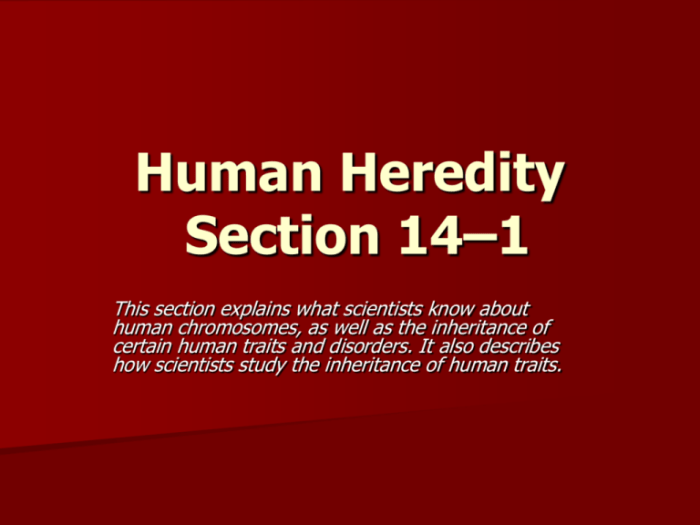Section 14-1 human heredity answer key – Step into the realm of human heredity with our comprehensive guide to Section 14-1. Unravel the mysteries of inheritance, tracing the path from DNA to observable traits. Discover the principles that govern genetic inheritance and explore the intricacies of human genetic disorders.
Through engaging storytelling and authoritative insights, we’ll illuminate the fascinating world of human heredity, empowering you with a deeper understanding of this fundamental aspect of human biology.
1. Introduction to Human Heredity
Human heredity refers to the passing of genetic traits from parents to offspring. It is a complex process involving the inheritance of genetic material, DNA, which carries instructions for various characteristics. Understanding human heredity is crucial for comprehending the biological basis of human traits, diseases, and evolution.
The basic principles of inheritance involve the concept of dominant and recessive alleles. Dominant alleles are those that express their traits even when paired with a recessive allele, while recessive alleles only express their traits when paired with another recessive allele.
DNA, organized into chromosomes, serves as the physical carrier of genetic information, determining the traits inherited by offspring.
2. Mendelian Inheritance
Gregor Mendel, an Austrian monk, conducted groundbreaking experiments with pea plants in the mid-19th century, establishing the fundamental principles of inheritance. His laws of inheritance, including the law of segregation and the law of independent assortment, provide a framework for understanding how traits are passed from one generation to the next.
Genotypes refer to the genetic makeup of an individual, while phenotypes represent the observable traits resulting from the interaction of genes with the environment. Mendelian inheritance patterns include dominant-recessive inheritance, where one allele masks the expression of another, and codominance, where both alleles are expressed simultaneously.
3. Extensions of Mendelian Inheritance
Incomplete dominance occurs when neither allele is dominant, resulting in an intermediate phenotype. Codominance, on the other hand, occurs when both alleles are fully expressed in the phenotype. Multiple alleles exist for some genes, leading to a wider range of phenotypic variations.
Sex-linked traits are inherited differently in males and females due to the presence of sex chromosomes (X and Y). These traits are typically located on the X chromosome, and males, who have only one X chromosome, are more likely to express recessive traits linked to the X chromosome.
4. Human Genetic Disorders
Human genetic disorders arise from alterations in the genetic material, resulting in various health conditions. Common types of genetic disorders include single-gene disorders, chromosomal disorders, and multifactorial disorders.
Single-gene disorders are caused by mutations in a single gene, such as cystic fibrosis or sickle cell anemia. Chromosomal disorders result from abnormalities in chromosome structure or number, such as Down syndrome or Turner syndrome. Multifactorial disorders involve the interaction of multiple genes and environmental factors, such as heart disease or diabetes.
5. Human Genome Project

The Human Genome Project, a massive international effort completed in 2003, aimed to sequence the entire human genome. This project has revolutionized our understanding of human heredity, providing insights into gene function, genetic variation, and the genetic basis of diseases.
The ethical and social implications of the Human Genome Project have also been significant, raising concerns about genetic privacy, discrimination, and the potential misuse of genetic information.
6. Advanced Topics in Human Heredity

Epigenetics explores the influence of environmental factors on gene expression without altering the underlying DNA sequence. Genetic engineering techniques, such as CRISPR-Cas9, allow for precise manipulation of the genome, raising ethical and societal considerations.
Ongoing research in human heredity continues to advance our understanding of genetic diversity, complex traits, and the role of genetics in human health and evolution.
Common Queries: Section 14-1 Human Heredity Answer Key
What is human heredity?
Human heredity refers to the passing on of genetic traits from parents to offspring. It involves the transmission of genetic information encoded in DNA, which determines various characteristics and predispositions in individuals.
Explain the significance of DNA in heredity.
DNA (deoxyribonucleic acid) serves as the blueprint for genetic inheritance. It contains the instructions that determine the structure and function of proteins, which in turn influence an individual’s traits and characteristics.
What are the key principles of Mendelian inheritance?
Mendelian inheritance, based on the work of Gregor Mendel, Artikels the principles of dominant and recessive alleles. Dominant alleles mask the expression of recessive alleles, leading to observable patterns of inheritance.